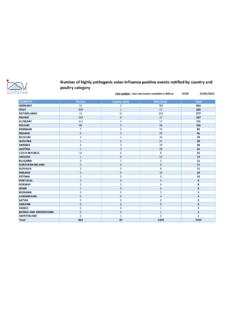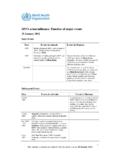Transcription of Notifiable avian disease control strategy for GB - GOV.UK
1 Notifiable avian disease control strategy for Great Britain Last updated September 2019 Crown copyright 2018 You may re-use this information (excluding logos) free of charge in any format or medium, under the terms of the Open Government Licence To view this licence visit or email This publication is available at Any enquiries regarding this publication should be sent to us at Animal Health Policy and Implementation Defra Area 2D Nobel House 17 Smith Square London SW1P 3JR PB 14317 Version control Version Published 25 January 2012 Version Published 5 July 2012. Text on rare breeds on page 46 has been revised, with reference to the UK Breeds at Risk List (published July 2012) for clarity.
2 Version Published 15 October 2015. Additional text to clarify the position on Prevention Zones has been added on page 16, on Compensation and Disposal on pages 28-30, Secondary Cleansing and Disinfection on pages 30-31 and Temporary control Zones on pages 38-39. Details of the Testing for Exclusion scheme have been added on page 19. Version Published 30 August 2018. Additional introductory text added on page 1, reference to the time period allowed for a derogation allowing the continued marketing of free range eggs and poultrymeat as free range during a housing order updated on page 43 and where otherwise mentioned, new section on Trade added on page 24, change from the use of individual valuers to commissioning new rate card where none is already available on page 29, previous text indicating option to allow licensing removal of eggs to a packaging or processing centre removed from page 30, changes to secondary cleansing and disinfection policy on pages 30-31.
3 Version Published 26 September 2019. Amendment to the text on the GB poultry register on page 14. Text on secondary cleansing and disinfection on pages 30-31 have been revised to reflect the update in policy, reference to APHA as a European Union reference laboratory has been amended to reflect current status of the laboratory on page 20, and where otherwise mentioned. Contents Foreword and introduction .. 1 Purpose and structure of document .. 1 Approach .. 1 Strategic fit .. 2 disease strategic control framework .. 2 Definitions of Notifiable avian disease .. 5 avian influenza .. 5 Newcastle disease .. 7 Previous outbreaks in GB .. 8 Maintaining disease freedom .. 10 Vigilance and prompt reporting .. 10 Biosecurity.
4 10 Surveillance .. 11 Imports .. 11 Preventive vaccination .. 12 Great Britain Poultry Register .. 14 Movement 14 Bird gatherings .. 14 Raising stakeholder awareness .. 15 Heightened risk of incursions of Notifiable avian disease into Great Britain .. 16 International surveillance and monitoring .. 16 Prevention zone .. 16 Suspicion of Notifiable avian disease in Great Britain .. 18 General principles .. 18 Notification to Animal and Plant Health Agency .. 18 Actions at suspect premises .. 19 Diagnostic investigation at the Animal and Plant Health Agency .. 21 High level of suspicion .. 21 Suspicion at slaughterhouses .. 22 Area restrictions around the suspect premises .. 23 Confirmation of influenza A virus or APMV-1 infections in poultry or other captive birds outside the definition of Notifiable avian disease .
5 23 Confirmation of a case of Notifiable avian disease in Great Britain .. 24 Confirming Notifiable avian disease .. 24 International notification obligations .. 24 Trade .. 24 Actions at infected premises (IP) .. 26 Measures .. 26 Derogations .. 26 Worker protection .. 26 Food safety .. 27 Culling of birds .. 27 Compensation and valuation .. 28 Disposal .. 30 Initial (preliminary) cleansing and disinfection .. 30 Secondary cleansing and disinfection .. 30 Restocking of depopulated premises .. 31 Confirmation of Notifiable avian disease in a slaughterhouse .. 32 Tracing and contact premises .. 33 Tracing of poultry (including game birds, other poultry species and poultry kept as pets) meat and eggs from an infected premises.
6 33 Contact premises and other suspect cases .. 35 disease control 37 General principles .. 37 Cross-border zones in Great Britain .. 37 Size of zones .. 37 Types of zones .. 38 Surveillance within the zones .. 40 Duration of zones .. 41 Measures within zones .. 41 Firebreak cull .. 44 Controls outside zones .. 44 Derogations .. 46 Derogation from culling birds .. 46 Derogation from declaring control zones .. 47 Emergency Vaccination .. 49 avian influenza .. 49 Newcastle disease .. 49 avian influenza : pigs and other mammals .. 50 Overview .. 50 avian influenza confirmed at infected premises where pigs are kept .. 50 Suspect influenza in pigs .. 50 influenza A virus of avian origin confirmed in pigs not at an existing infected premises 51 Preventing avian influenza in wild birds from transmitting to pigs.
7 51 Preventing avian influenza in poultry (including game birds, other poultry species and poultry kept as pets) or other captive birds from transmitting to pigs and other mammals .. 51 highly pathogenic avian influenza H5N1 in wild birds .. 52 Confirming highly pathogenic avian influenza H5N1 in wild birds .. 52 Culling of wild birds .. 52 General principles .. 52 Size of areas .. 52 Surveillance within zones .. 53 Duration of zones .. 53 Measures within zones .. 54 Controls outside disease control areas .. 57 Exiting from movement restrictions .. 58 disease control zones .. 58 Exports .. 61 Recovering International disease Free Status .. 61 Annex 1 - Glossary of Terms .. 63 Annex 2 European and GB legislation for the control of NAD.
8 67 1 Foreword and introduction Purpose and structure of document 1 The purpose of this strategy is to inform all keepers of poultry (which includes the egg and meat industry, game bird industry and keepers who identify themselves as either pet owners or hobbyists please see paragraph 4 below for full description) and other captive birds (please see paragraph 5 below for full description) about the actions that government will take to control and eradicate Notifiable avian disease (NAD). It details why actions are taken and who does them, who it affects and what you, as a keeper, need to do and why. 2 This document describes how an outbreak of exotic NAD in Great Britain (GB) would be managed and sets out the measures that would be applied.
9 It also describes the measures and wider framework in place to prevent and limit an incursion of NAD. 3 The strategy aims to enable all affected during an outbreak of NAD to be better prepared to respond quickly and effectively to control and limit the outbreak, thereby mitigating the likely impact of the control measures described. 4 Poultry is defined as all birds that are reared or kept in captivity for the production of meat or eggs for consumption, the production of other products, for restocking supplies of game birds or for the purposes of any breeding programme for the production of these categories of birds. Examples being: Chickens, ducks, turkeys, geese, pigeon (bred for meat), partridge, quail, guinea fowl and pheasants.
10 5 Other captive birds includes any bird kept in captivity which is not poultry and includes pet birds and birds kept for shows, races, exhibitions, competitions, breeding or for sale. Examples include: canaries, finches, cockatiels, parrots, penguins, puffins, flamingos and racing pigeons. 6 A glossary of terms and acronyms used in the strategy is contained in Annex 1 - Glossary of Terms. Approach 7 Since NAD could spread throughout GB irrespective of regional and political boundaries, the approach to managing an outbreak seeks complementary, consistent and coordinated measures in all regions. This control strategy is endorsed by the Department for Environment, Food and Rural Affairs (Defra), Scottish government (SG) and Welsh Government (WG) (referred to as government in this document).











